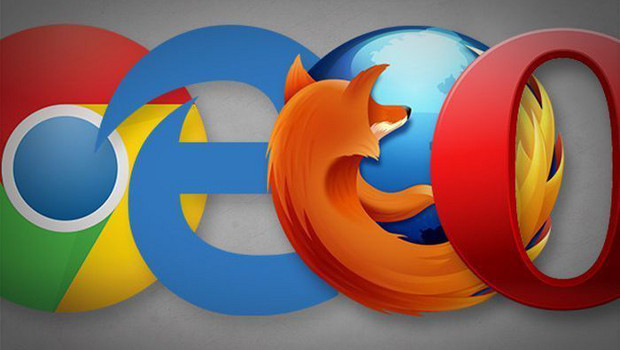Microsoft’s and Mozilla’s browsers fell to new lows in July as users continued to switch to Google’s behemoth, Chrome, which again looks unstoppable.
According to California-based analytics vendor Net Applications, Microsoft’s Internet Explorer (IE) and Edge dropped to a combined user share of 15.4% last month, down a whopping 3.8 percentage points from June. Meanwhile, Mozilla’s Firefox cast off a much smaller two-tenths of a percentage point, recording a user share of 9.7%. Microsoft’s July number was a record low in Computerworld’s tracking of browser data, which began in 2005. Firefox’s figure was its smallest user share since February 2006, when it was fighting for the scraps left by the then-dominant IE.
Net Applications calculates user share by detecting the agent strings of the browsers people use to visit its clients’ websites. It then tallies the visitor sessions – which are effectively visits to the site, with multiple sessions possible daily – rather than count only users, as it once did. Net Applications primarily measures activity, although it does so differently than rival sources, which total page views.
A long downhill slide
Microsoft’s troubles appeared more dire, as its IE and Edge have shown few signs of stanching their continued losses. With very few exceptions – notably in June, which in hindsight now looks to have been a miscount by Net Applications – IE and Edge have shed share month after month after month. Of the past 24 months, for example, IE and Edge lost share in 19. In the last year, the IE-and-Edge user share dropped by 6.8 percentage points, a 31% decline from the July 31, 2017 mark.
Firefox was in a leaky boat, too. July was the third consecutive month in which Mozilla’s open-source browser posted a number under the 10% bar. In the past year, Firefox has lost 2.6 percentage points, or 21% of its July 31, 2017, user share.
If the trends of the last 12 months continue and IE and Edge lose another 31% in the next year, they will account for just 10.6% of the world’s browser user share by this time in 2019. If Firefox again drops by 21%, it will fall to 7.6% in the same period. (Because IE and Edge lost more than twice as much each of the last 12 months as Firefox, Microsoft’s browsers will fall faster than Mozilla’s under this forecasting model.)
Ironically, Firefox may have the best shot at beating that prediction. That’s because Firefox survived a near-death experience relatively recently to bounce back to some degree. Two years ago this month, Net Applications reported that Firefox’s user share had sunk to a record low of just 7.7%. But over the next year and two months, the browser clawed itself back to 13.1%. (Since October 2017, Firefox has lost share in all but one month.)
Microsoft’s Internet Explorer – Edge was not yet around – had a come-back, too: IE climbed from a December 2011 flirtation with 50% to grow to 59.1% three years later. But IE, and then IE + Edge, have lost ground, first slowly, then more rapidly, since December 2014. In other words, Microsoft’s browser slide has been on-going for more than three and a half years, significantly longer than Firefox’s nine-month decline.
An ominous future for IE and Edge
The future of IE and Edge look nearly as ominous if the user share calculation considers their place within the Windows ecosystem, the only platform available to the browsers. According to Net Applications, IE and Edge accounted for 17.4% of the browsers that ran on Windows in July. (The 17.4% was larger than the 15.4% IE and Edge tallied overall because Windows does not power 100% of all PCs; in July, it ran 88.4% of the world’s systems.) Darker clouds await, however. IE, already relegated to legacy status, will increasingly be disowned by commercial customers as they adopt Windows 10 and modernise the Web apps and websites that now require them to support the old browser. That will leave Edge as the only competitive browser in Microsoft’s arsenal.
And Edge remains a flop. In July, just 11.5% of all Windows 10 users relied on Edge, a record low for the long-struggling browser. To get an idea of Edge’s loose hold on Windows 10, consider that the browser was being used by almost twice the percentage of 10’s owners, 20.4%, only 12 months ago.
In the zero-sum browser battle, Microsoft’s and Mozilla’s losses became Google’s gains: Chrome added nearly 4 percentage points to its user share in July, ending at 64.7%. The last time a browser owned that large a chunk of the world’s browser market was in late 2009, when IE accounted for two-thirds of the total.
Calculations by Computerworld now put Chrome on a faster track to that same two-thirds dominance. Using the average monthly change over the past 12 months, Computerworld now expects Chrome to reach 66.7% or more in December and make it to 70% by August 2019.
The 12-month average for Microsoft’s and Mozilla’s browsers paints a different picture. IE and Edge will account for less than 12% of all user share by February 2019, then fall under 10% by May. Firefox will continue its decline as well, slipping below 9% in November and dipping under 8% in March 2019.
Elsewhere in Net Applications’ data, the user share number for Apple’s Safari fell for the third straight month, ending at 3.5%, its lowest since April 2017. Safari’s share of all macOS-powered systems also dropped to 38.3% in July, reinforcing Computerworld’s analysis last month that being an operating system’s default browser no longer guarantees success.
IDG News Service








Subscribers 0
Fans 0
Followers 0
Followers